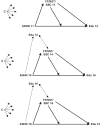ADHD Symptoms and Educational Level in Adolescents: The Role of the Family, Teachers, and Peers
- PMID: 36952076
- PMCID: PMC10271900
- DOI: 10.1007/s10802-023-01047-y
ADHD Symptoms and Educational Level in Adolescents: The Role of the Family, Teachers, and Peers
Abstract
Few studies have explored the contribution of family and school factors to the association between ADHD symptoms and lower education. Possibly, having more ADHD symptoms contributes to poorer family functioning and less social support, and consequently a lower educational level (i.e., mediation). Moreover, the negative effects of ADHD symptoms on education may be stronger for adolescents with poorer family functioning or less social support (i.e., interaction). Using data of the Dutch TRAILS Study (N = 2,229), we evaluated associations between ADHD symptoms around age 11 and educational level around age 14, as well as between ADHD symptoms around age 14 and 16 years and subsequent changes in educational level around age 16 and 19, respectively. We assessed the potential mediating role of family functioning, and social support by teachers and classmates, all measured around ages 11, 14, and 16, while additionally evaluating interactions between ADHD symptoms and these hypothesized mediators. ADHD symptoms were associated with poorer family functioning, less social support by teachers and classmates, and lower education throughout adolescence. No conclusive evidence of mediation was found, because unique associations between family functioning and social support by teachers and classmates and education were largely absent. Furthermore, we found no interactions between ADHD symptoms and family functioning and social support by teachers and classmates. Although social support by teachers and classmates and good family functioning may benefit the wellbeing and mental health of adolescents with high levels of ADHD symptoms, they will not necessarily improve their educational attainment.
Keywords: ADHD; Education; Family functioning; Peers; Social support; Teachers.
© 2023. The Author(s).
Conflict of interest statement
The authors declare that they have no conflicts of interest.
Figures


Similar articles
-
Health-related quality of life in children and adolescents who have a diagnosis of attention-deficit/hyperactivity disorder.Pediatrics. 2004 Nov;114(5):e541-7. doi: 10.1542/peds.2004-0844. Pediatrics. 2004. PMID: 15520087
-
Children's ADHD Symptoms and Friendship Patterns across a School Year.Res Child Adolesc Psychopathol. 2021 May;49(5):643-656. doi: 10.1007/s10802-021-00771-7. Epub 2021 Feb 2. Res Child Adolesc Psychopathol. 2021. PMID: 33532873
-
Sluggish cognitive tempo among young adolescents with ADHD: relations to mental health, academic, and social functioning.J Atten Disord. 2013 Nov;17(8):681-9. doi: 10.1177/1087054711435411. Epub 2012 Mar 21. J Atten Disord. 2013. PMID: 22441891
-
An examination of the association between anxiety and social functioning in youth with ADHD: A systematic review.Psychiatry Res. 2019 Mar;273:402-421. doi: 10.1016/j.psychres.2019.01.039. Epub 2019 Jan 14. Psychiatry Res. 2019. PMID: 30684786
-
Beyond symptom control for attention-deficit hyperactivity disorder (ADHD): what can parents do to improve outcomes?Child Care Health Dev. 2015 Jan;41(1):1-14. doi: 10.1111/cch.12159. Epub 2014 Jun 9. Child Care Health Dev. 2015. PMID: 24910021 Review.
Cited by
-
The Impact of Teacher and Peer Support on Preservice EFL Teachers' Work Engagement in Their Teaching Practicum: The Mediating Role of Teacher L2 Grit and Language Teaching Enjoyment.Behav Sci (Basel). 2024 Sep 6;14(9):785. doi: 10.3390/bs14090785. Behav Sci (Basel). 2024. PMID: 39336000 Free PMC article.
-
Associations between Parental Educational Attainment, Children's 24-h Behaviors and Children's Hyperactivity Behavior in the COVID-19 Pandemic.Healthcare (Basel). 2024 Feb 21;12(5):516. doi: 10.3390/healthcare12050516. Healthcare (Basel). 2024. PMID: 38470627 Free PMC article.
-
Prevalence of adult attention deficit hyperactivity disorder (ADHD) among medical students in the Eastern Province of Saudi Arabia.Saudi Med J. 2024 Apr;45(4):397-404. doi: 10.15537/smj.2024.45.4.20230841. Saudi Med J. 2024. PMID: 38657995 Free PMC article.
-
Investigating Attention Deficit Hyperactivity Disorder Symptoms, Emotional Dysregulation and Family Functioning in Children: A Community-Based Study in Elementary Schools in Surabaya, Indonesia.J Korean Acad Child Adolesc Psychiatry. 2024 Oct 1;35(4):250-257. doi: 10.5765/jkacap.240015. J Korean Acad Child Adolesc Psychiatry. 2024. PMID: 39380565 Free PMC article.
References
-
- Achenbach TM, Rescorla L. Manual for the ASEBA school age forms & profiles: an integrated system of multi-informant assessment. Burlington: ASEBA; 2001.
-
- Alwin DF, Hauser RM. The decomposition of effects in path analysis. American Sociological Review. 1975;40:37–47. doi: 10.2307/2094445. - DOI
MeSH terms
Grants and funding
LinkOut - more resources
Full Text Sources
Medical
